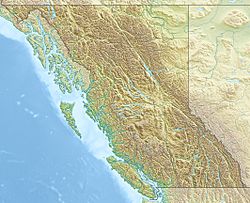Pachena Point Light facts for kids
|
|
|
| Location | Pachena Point Vancouver Island British Columbia Canada |
|---|---|
| Coordinates | 48°43′19.6″N 125°05′51.2″W / 48.722111°N 125.097556°W |
| Year first lit | 1908 |
| Construction | wooden tower |
| Tower shape | octagonal tower with balcony and lantern |
| Markings / pattern | white tower, red lantern |
| Height | 66 feet (20 m) |
| Focal height | 154 feet (47 m) |
| Original lens | First order Fresnel lens |
| Range | 14 nautical miles (26 km; 16 mi) |
| Characteristic | Fl (2) W 7.5 seconds |
| Admiralty number | G5280 |
| CHS number | CCG 0178 |
| NGA number | 13828 |
| ARLHS number | CAN-362 |
The Pachena Point Lighthouse is a historic and important lighthouse found on Vancouver Island in British Columbia, Canada. It's about 13 kilometers (8 miles) south of a small town called Bamfield, British Columbia. This lighthouse is special because it's located right inside the amazing Pacific Rim National Park.
The lighthouse has a unique octagonal (eight-sided) shape and is built from wood. It's still actively looked after by the Canadian Coast Guard. What makes it even more interesting is that real lighthouse keepers still live and work at the station, making sure the light shines brightly.
Contents
Why Lighthouses Are Important
Lighthouses like Pachena Point are super important for ships and boats. They act like giant traffic lights for the ocean. Before modern navigation tools, sailors relied on these bright lights to find their way.
They helped ships avoid dangerous rocks and shallow waters, especially at night or in bad weather. Lighthouses guided vessels safely into harbors and along busy coastlines. The Pachena Point Lighthouse sits on a very rugged part of the coast. This area is known for its strong storms and tricky waters.
The West Coast Trail and Shipwrecks
The coast near Pachena Point is famous for the West Coast Trail. This trail was originally built as a path for survivors of shipwrecks. Many ships ran into trouble along this part of Vancouver Island.
The Pachena Point Lighthouse was built to help prevent more disasters. It shines its light across the ocean, warning ships of the nearby land. This makes the waters much safer for everyone traveling by sea.
How the Lighthouse Works
The Pachena Point Lighthouse has a powerful light that can be seen from far away. It uses a special type of lens called a Fresnel lens. This lens was invented by a French scientist named Augustin-Jean Fresnel.
A Fresnel lens is amazing because it can make a small light source look very bright and focused. It does this by using many rings of glass that bend the light. This way, the light from the lighthouse can travel many kilometers across the water.
The Light's Special Pattern
Every lighthouse has a unique "flash pattern" or characteristic. This is like its own secret code. Ships can tell which lighthouse they are seeing by looking at its pattern.
The Pachena Point Lighthouse has a characteristic of "Fl (2) W 7.5 seconds." This means its light flashes twice (Fl (2)) and is white (W). This whole pattern repeats every 7.5 seconds. This unique signal helps sailors know exactly where they are along the coast.
Life as a Lighthouse Keeper
Lighthouse keepers are the brave people who live at the lighthouse and make sure it works perfectly. It's a very important job, and it can be quite lonely. Keepers often live in remote places, far from towns.
Their main tasks include:
- Keeping the light clean and working.
- Making sure the machinery is in good shape.
- Reporting weather conditions.
- Helping ships in distress.
Many dedicated keepers have worked at Pachena Point since it first opened. They have spent years living by the ocean, watching over the light. Their hard work has saved countless lives and ships over the decades.
Famous Keepers
One notable keeper was John Alfred Hunting, who served for many years. He worked at Pachena Point from 1924 to 1958, with a short break. Keepers like him were essential for the safety of ships passing by. Their commitment ensured the light never went out.
History of Pachena Point Lighthouse
The Pachena Point Lighthouse was first lit in 1908. It was built at a time when sea travel was very common. There were no GPS systems or advanced radars back then. Lighthouses were the main way to navigate safely.
The lighthouse is made of wood and has stood strong for over a hundred years. It has seen many storms and changes in technology. Even with new tools, the lighthouse remains an important symbol of safety and guidance on the coast.


